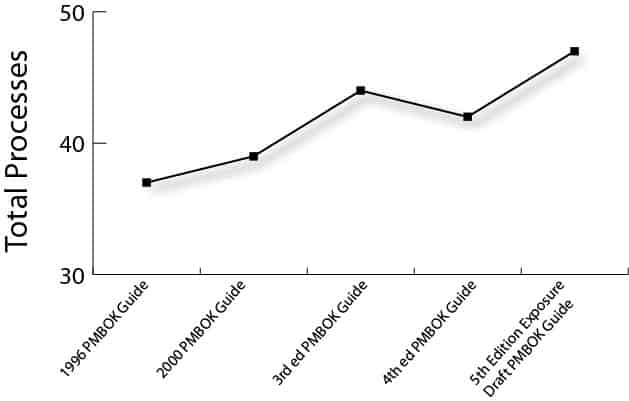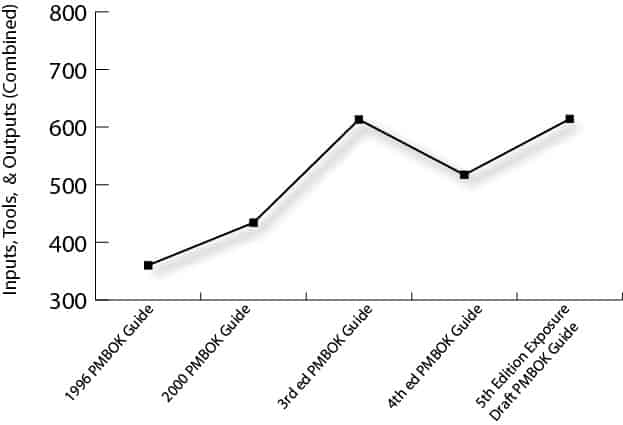
First off, the traditional process groups of Initiating, Planning Executing, Monitoring and Controlling, and Closing are unchanged. This is still the context for the flow of processes and activities, and this should come as a sigh of relief.
The knowledge areas have expanded to include Stakeholder Management. This change makes some sense if you think of most of the knowledge areas as looking inward at the project itself. You need some to look outward at the stakeholders, it traditionally fell under communications, but we all know that real stakeholder management may require more than just communication. I have long advocated for more attention to be given to Issue Management along those same lines.
There are now 47 processes in the 5th edition PMBOK Guide exposure draft, representing a 12% increase over the 4th edition. The concept that each knowledge area should have a master planning process has made a return. This was attempted in the 3rd edition but was mysteriously abandoned in the 4th edition. Now it’s back with new processes such as “Plan Scope Management” and “Plan Human Resource Management.” This was a needed reorganization for the sake of consistency.
However, the overall PMBOK Guide draft is much larger, and jumps of this size always make me nervous as a practitioner. When we look back in time at previous PMBOK Guides, we can see the size of content (processes and input/tools/outputs) growing over time per the following graphs:
Before you assume that the new processes are simply an organization of practices that have been reflected in the PMBOK Guide all along, let’s look beneath the processes at the inputs, tools, and outputs associated with each. This draft hits another record, with 614 inputs, tools, and outputs. That represents a whopping 19% increase over the 4th edition.
Another curiosity is that I only found the word “agile” in the body of the exposure draft a total of six times (it didn’t make the glossary at all). It does address adaptive methodologies, which it uses as a device to encompass agile, but it’s interesting that agile isn’t given more of a role here – especially given the expanded role that Agile is taking within PMI.
And this raises an interesting question: Is the PMBOK Guide intended to be a guide to all project management or primarily to waterfall project management? If it is intended to encompass agile, then it’s curious that the words “planning poker”, “Fibonacci”, “self-organizing”, “osmotic”, and “disaggregation” do not appear anywhere in the exposure draft, but traditional vocabulary techniques like “Delphi”, “dependency”, and “WBS” are well-represented.
This will undoubtedly have many asking if there is a need for a separate Agile Body of Knowledge and what role does the PMBOK Guide want to play in the agile world.
My cursory evaluation has led me to the conclusion that stakeholder management was a positive addition to the organization of the 5th edition; however, the corresponding bloat in processes, inputs, tools, and outputs (and overall content) is not as welcome. The simple truth is that the more the standard grows, the more unwieldy it becomes (the 1996 PMBOK Guide was a useful 176 pages, while the 4th edition was 476 pages and was correspondingly more difficult to navigate. The 5th edition will almost certainly be even longer). Organizations try to develop methodologies from this, and every four years these undergo significant upheaval. If the change is because of new practices that are emerging, then it is welcome, but if it is simply another committee leaving their mark, then it is not so welcome. I believe that PMI would be well served by scrutinizing every change going forward.
If you have seen the 5th Edition PMBOK Guide Exposure, what are your thoughts?



